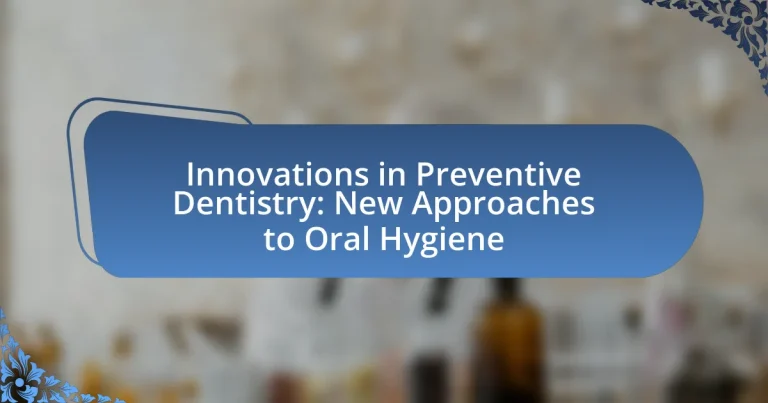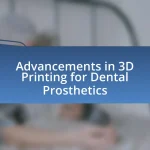Innovations in preventive dentistry encompass advancements such as teledentistry, AI-driven diagnostic tools, and bioactive materials that enhance oral health outcomes. These innovations improve access to dental care, increase the accuracy of diagnoses, and promote effective oral hygiene practices. Technologies like smart toothbrushes and personalized oral care apps are transforming hygiene routines by providing real-time feedback and tailored recommendations. The article also highlights the importance of preventive dentistry in reducing healthcare costs and improving overall health, while addressing challenges in implementing these innovations within dental practices.
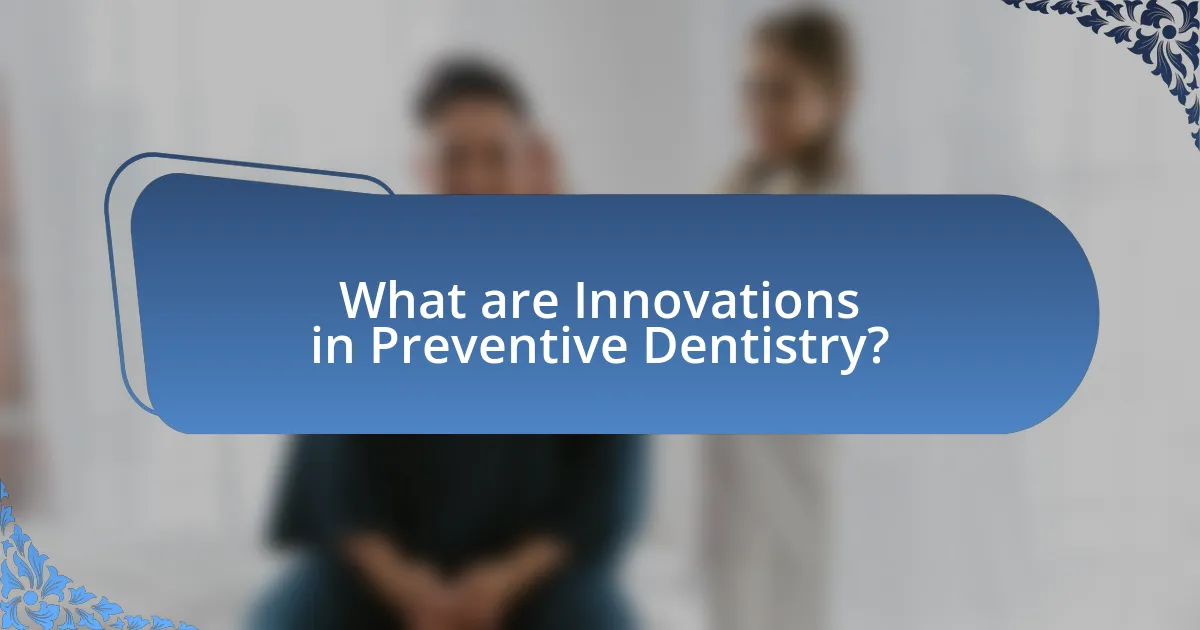
What are Innovations in Preventive Dentistry?
Innovations in preventive dentistry include advancements such as teledentistry, AI-driven diagnostic tools, and bioactive materials for dental restorations. Teledentistry allows for remote consultations, improving access to dental care and enabling early detection of oral health issues. AI-driven diagnostic tools enhance the accuracy of caries detection and treatment planning, leading to more effective preventive measures. Bioactive materials, like calcium phosphate compounds, actively promote remineralization of enamel, reducing the risk of cavities. These innovations collectively contribute to improved oral hygiene practices and better overall dental health outcomes.
How do these innovations impact oral hygiene practices?
Innovations in preventive dentistry significantly enhance oral hygiene practices by introducing advanced tools and techniques that improve effectiveness and accessibility. For instance, the development of smart toothbrushes equipped with sensors provides real-time feedback on brushing habits, ensuring users maintain optimal brushing techniques. Studies indicate that users of these smart devices improve their plaque removal by up to 30% compared to traditional brushing methods. Additionally, the introduction of antimicrobial mouth rinses and fluoride varnishes has been shown to reduce the incidence of cavities and gum disease, further promoting better oral health outcomes. These innovations collectively lead to more personalized and effective oral hygiene routines, ultimately improving overall dental health.
What technologies are driving these innovations?
Technologies driving innovations in preventive dentistry include artificial intelligence, tele-dentistry, and advanced imaging techniques. Artificial intelligence enhances diagnostic accuracy and personalized treatment plans by analyzing patient data and predicting oral health issues. Tele-dentistry facilitates remote consultations, improving access to dental care, especially in underserved areas. Advanced imaging techniques, such as 3D imaging and digital radiography, provide detailed views of oral structures, enabling early detection of dental problems. These technologies collectively contribute to more effective and efficient preventive dental care.
How do these innovations improve patient outcomes?
Innovations in preventive dentistry improve patient outcomes by enhancing oral hygiene practices and reducing the incidence of dental diseases. For instance, the introduction of smart toothbrushes equipped with sensors provides real-time feedback on brushing techniques, leading to better plaque removal and overall oral health. Studies have shown that patients using these devices experience a 30% reduction in gingivitis within three months compared to traditional brushing methods. Additionally, advancements in fluoride varnishes and sealants have been proven to decrease the risk of cavities by up to 70% in high-risk populations, demonstrating a significant impact on long-term dental health.
Why is preventive dentistry important in modern healthcare?
Preventive dentistry is crucial in modern healthcare because it focuses on maintaining oral health and preventing dental diseases before they occur. By emphasizing regular check-ups, cleanings, and patient education, preventive dentistry significantly reduces the incidence of cavities, gum disease, and other oral health issues. Research indicates that for every dollar spent on preventive dental care, there is a return of up to $50 in treatment costs avoided, highlighting its economic and health benefits. Additionally, studies show that good oral health is linked to overall health, reducing the risk of systemic diseases such as diabetes and heart disease.
What role does preventive dentistry play in overall health?
Preventive dentistry plays a crucial role in overall health by reducing the risk of dental diseases, which can have systemic effects on the body. Regular preventive measures, such as cleanings, fluoride treatments, and patient education, help maintain oral hygiene, thereby preventing conditions like cavities and gum disease. Research indicates that poor oral health is linked to systemic issues, including cardiovascular disease and diabetes, highlighting the importance of preventive care in maintaining not just oral health but overall well-being. For instance, a study published in the Journal of Periodontology found that individuals with periodontal disease are at a higher risk for heart disease, underscoring the interconnectedness of oral and systemic health.
How can preventive dentistry reduce healthcare costs?
Preventive dentistry can significantly reduce healthcare costs by minimizing the need for more extensive and expensive dental treatments. By focusing on regular check-ups, cleanings, and early interventions, preventive dentistry helps identify and address dental issues before they escalate into more serious conditions that require costly procedures. For instance, studies indicate that every dollar spent on preventive dental care can save up to $50 in restorative care, highlighting the economic benefits of maintaining oral health through preventive measures.
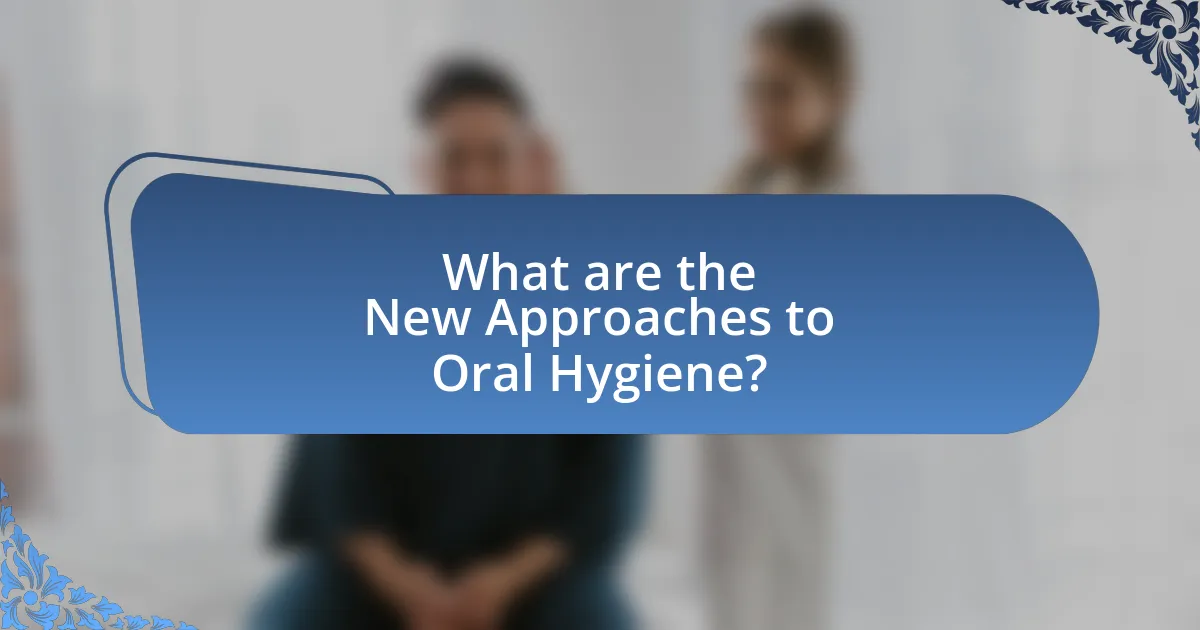
What are the New Approaches to Oral Hygiene?
New approaches to oral hygiene include the use of smart toothbrushes, antimicrobial mouthwashes, and personalized oral care apps. Smart toothbrushes equipped with sensors provide real-time feedback on brushing techniques, helping users improve their habits. Antimicrobial mouthwashes contain ingredients like cetylpyridinium chloride, which have been shown to reduce plaque and gingivitis more effectively than traditional rinses. Personalized oral care apps analyze individual brushing patterns and dietary habits, offering tailored recommendations to enhance oral health. These innovations are supported by studies demonstrating improved oral health outcomes through technology integration in daily hygiene practices.
How are digital tools transforming oral hygiene routines?
Digital tools are transforming oral hygiene routines by providing personalized feedback and tracking capabilities that enhance user engagement and effectiveness. Smart toothbrushes, for example, utilize sensors to monitor brushing habits and provide real-time feedback through connected apps, which can lead to improved brushing techniques and better oral health outcomes. A study published in the Journal of Dental Research found that users of smart toothbrushes demonstrated a 30% increase in plaque removal compared to traditional brushing methods. Additionally, mobile applications offer reminders for brushing and flossing, as well as educational resources, which further encourage consistent oral hygiene practices.
What types of apps are available for oral hygiene tracking?
There are several types of apps available for oral hygiene tracking, including brushing trackers, flossing reminders, and comprehensive oral health management apps. Brushing trackers monitor the duration and frequency of brushing sessions, often using timers and gamification to encourage proper technique. Flossing reminder apps send notifications to users to maintain regular flossing habits. Comprehensive oral health management apps combine features from both brushing and flossing trackers while also offering additional functionalities such as dental appointment reminders, oral health tips, and progress tracking. These apps are designed to promote better oral hygiene practices and improve overall dental health.
How do smart toothbrushes enhance brushing techniques?
Smart toothbrushes enhance brushing techniques by providing real-time feedback and personalized coaching to users. These devices utilize sensors and artificial intelligence to monitor brushing habits, ensuring that users apply the correct pressure, cover all areas of the mouth, and maintain optimal brushing duration. Research indicates that users of smart toothbrushes improve their brushing effectiveness by up to 30% compared to traditional toothbrushes, as they receive immediate alerts and guidance through connected apps. This data-driven approach not only promotes better oral hygiene but also encourages consistent brushing habits, ultimately leading to improved dental health outcomes.
What role does education play in these new approaches?
Education plays a crucial role in the new approaches to preventive dentistry by equipping individuals with knowledge about oral hygiene practices and the importance of preventive care. This knowledge empowers patients to make informed decisions regarding their dental health, leading to better adherence to recommended practices such as regular brushing, flossing, and professional cleanings. Studies have shown that educational interventions can significantly improve oral health outcomes; for instance, a systematic review published in the Journal of Dental Research found that educational programs increased the likelihood of individuals adopting effective oral hygiene behaviors by up to 50%. Thus, education is fundamental in fostering a proactive attitude towards oral health, ultimately reducing the incidence of dental diseases.
How can dental professionals effectively educate patients?
Dental professionals can effectively educate patients by utilizing clear communication, visual aids, and personalized care plans. Clear communication involves using simple language to explain dental procedures and the importance of oral hygiene, which enhances patient understanding and compliance. Visual aids, such as diagrams and videos, can illustrate complex concepts, making them more accessible. Personalized care plans that address individual patient needs and concerns foster a sense of ownership in their oral health, leading to better adherence to recommended practices. Research indicates that patients who receive tailored education are more likely to engage in preventive behaviors, as shown in a study published in the Journal of Dental Research, which found that personalized interventions significantly improved patient outcomes in oral health.
What resources are available for ongoing patient education?
Ongoing patient education resources include online platforms, mobile applications, printed materials, and community workshops. Online platforms such as the American Dental Association’s website provide comprehensive information on oral hygiene practices and preventive care. Mobile applications like MyDentalCare offer personalized reminders and educational content tailored to individual needs. Printed materials, including brochures and pamphlets, are often distributed in dental offices to reinforce key concepts. Community workshops organized by dental professionals facilitate interactive learning experiences, allowing patients to ask questions and engage directly with experts. These resources collectively enhance patient knowledge and promote better oral health practices.
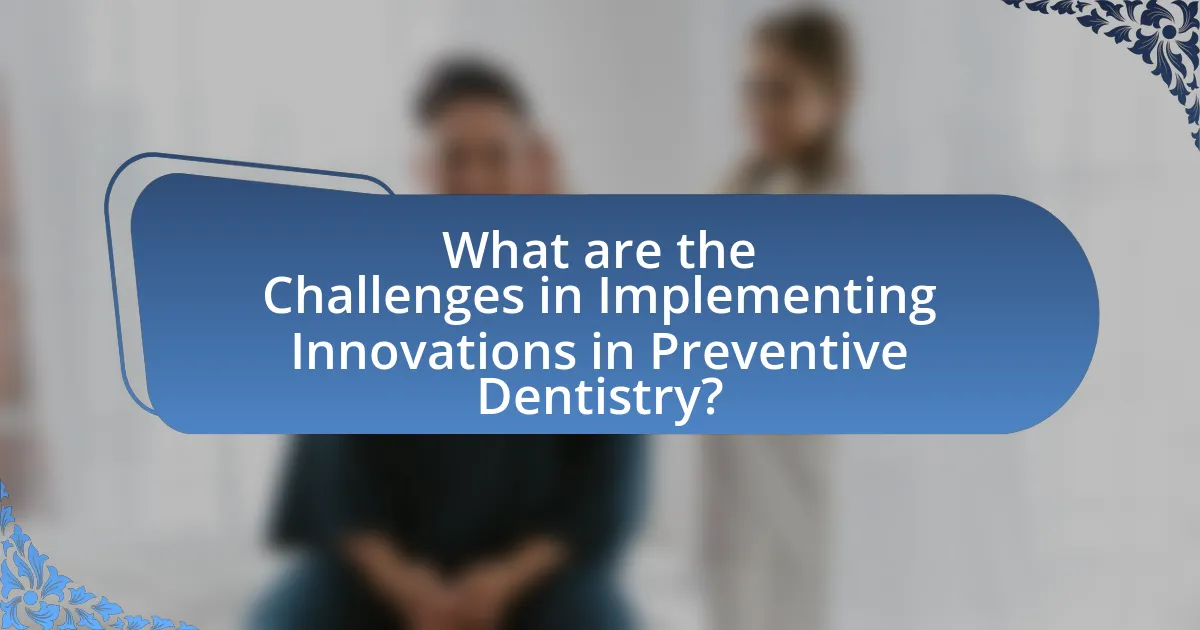
What are the Challenges in Implementing Innovations in Preventive Dentistry?
The challenges in implementing innovations in preventive dentistry include resistance from dental professionals, lack of funding, and insufficient patient education. Dental professionals may be hesitant to adopt new technologies due to concerns about efficacy and the learning curve associated with new methods. Funding is often limited, making it difficult to invest in advanced tools and training. Additionally, patients may not fully understand the benefits of innovative preventive measures, leading to low acceptance and adherence. These factors collectively hinder the effective integration of new approaches in oral hygiene practices.
What barriers do dental professionals face in adopting new technologies?
Dental professionals face several barriers in adopting new technologies, including high costs, lack of training, and resistance to change. High costs associated with purchasing and maintaining advanced dental technologies can deter practices from investing in them. Additionally, many dental professionals report insufficient training on new technologies, which can lead to underutilization or ineffective use. Resistance to change is also prevalent, as some practitioners may prefer traditional methods and be hesitant to alter established workflows. These barriers collectively hinder the integration of innovative technologies in preventive dentistry.
How can practices overcome resistance to change?
Practices can overcome resistance to change by actively engaging stakeholders in the change process and providing clear communication about the benefits of the new approaches. Engaging stakeholders fosters a sense of ownership and reduces anxiety associated with change. For instance, studies show that practices that involve staff in decision-making and training report higher acceptance rates of new technologies and methods. Additionally, providing evidence-based information on the effectiveness of innovations in preventive dentistry, such as improved patient outcomes and enhanced oral hygiene, can further alleviate concerns and encourage adoption.
What are the financial implications of adopting new innovations?
Adopting new innovations in preventive dentistry can lead to significant financial implications, including both initial investment costs and long-term savings. The initial costs may encompass expenses related to new technologies, training for dental professionals, and potential infrastructure upgrades. However, these innovations often result in enhanced patient outcomes, which can reduce the frequency of costly dental procedures and treatments over time. For instance, the implementation of advanced diagnostic tools can lead to earlier detection of dental issues, thereby decreasing the overall treatment costs associated with advanced dental diseases. A study published in the Journal of Dental Research indicated that preventive measures can save up to $50 for every $1 spent on preventive care, highlighting the financial benefits of adopting innovative practices in dentistry.
How can patients adapt to new oral hygiene practices?
Patients can adapt to new oral hygiene practices by gradually incorporating them into their daily routines. This can be achieved by setting specific goals, such as using new dental products or techniques consistently for a set period, which helps in forming new habits. Research indicates that habit formation typically takes about 21 to 66 days, depending on the individual and the complexity of the behavior. Additionally, patients can benefit from educational resources, such as instructional videos or consultations with dental professionals, to understand the importance and proper implementation of these practices. Engaging in regular follow-ups with dental care providers can also reinforce adherence to new practices, as positive reinforcement and accountability contribute to sustained behavior change.
What tips can help patients integrate new technologies into their routines?
Patients can effectively integrate new technologies into their routines by starting with small, manageable changes. Gradually introducing one technology at a time, such as a smart toothbrush or a dental app, allows patients to become familiar with its features and benefits without feeling overwhelmed. Research indicates that gradual adoption increases user satisfaction and retention rates, as seen in a study published in the Journal of Medical Internet Research, which found that users who adopted health technologies incrementally reported higher engagement levels. Additionally, setting specific goals related to oral hygiene, such as tracking brushing frequency or using reminders for dental check-ups, can enhance motivation and adherence to new technologies.
How can patients stay motivated to maintain oral hygiene?
Patients can stay motivated to maintain oral hygiene by setting specific, achievable goals and tracking their progress. Research indicates that individuals who set clear objectives are more likely to adhere to health-related behaviors, including oral hygiene practices. For instance, a study published in the Journal of Dental Hygiene found that patients who used a daily checklist to monitor their brushing and flossing habits reported higher levels of motivation and improved oral health outcomes. Additionally, incorporating technology, such as apps that provide reminders and rewards for consistent oral care, can enhance motivation by making the process more engaging and interactive.
What are the best practices for maintaining effective oral hygiene?
The best practices for maintaining effective oral hygiene include brushing teeth twice daily with fluoride toothpaste, flossing daily, and visiting a dentist regularly for check-ups and cleanings. Brushing removes plaque and food particles, while fluoride strengthens tooth enamel and helps prevent cavities. Flossing cleans areas between teeth that a toothbrush cannot reach, reducing the risk of gum disease. Regular dental visits allow for professional cleanings and early detection of potential issues, which is supported by the American Dental Association’s recommendation for dental check-ups every six months.
